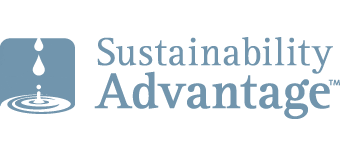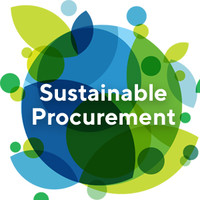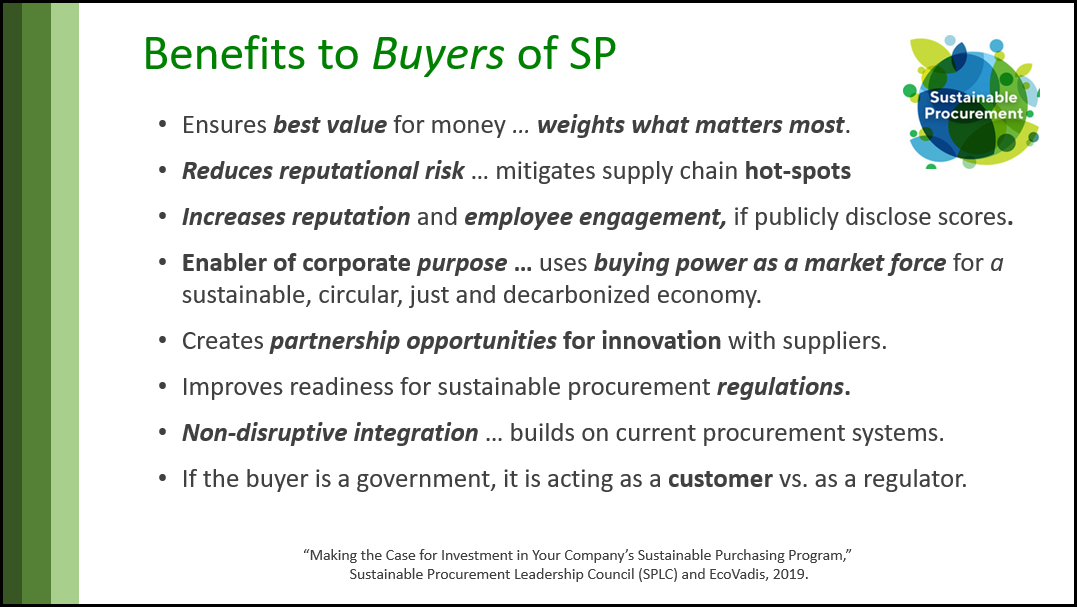Sustainable Procurement
What is Sustainable Procurement (SP)?
Here is the the four-part definition:
“Sustainable Procurement” ensures that buyers…
…obtain the best value for money by purchasing…
(i.e., best value and lowest risk, not necessarily the lowest price)
… the most sustainable goods and services…
(i.e., products that have the most environmental- and people-beneficial performance and content attributes)
…from the most sustainable suppliers, in support of…
(i.e. suppliers that have the most beneficial impacts on the environment, their employees, and their communities, directly and indirectly)
…the customer’s / buyer’s stated purpose and strategic goals.
(1.e., the buyer cares about its impacts on people and the planet, and accepts mutual accountability for indirect impacts by its supply chains)
See Decoding Sustainable Procurement and Its 4 Starter Subsets for an explanation of how Sustainable Procurement is the inclusive umbrella term for Social Procurement, Green Procurement, Net-Zero Procurement and Circular Procurement.
Context for the Importance of Sustainable Procurement
- 7 Bold Strokes to Save Our World,
This whitepaper positions Sustainable Procurement (Bold Stroke #3) as the most under-used and powerful market force that could accelerate us toward a resilient, decarbonized, circular, and socially-just socio-economic system. - 21st Century Sustainable Enterprise Force Field
This whitepaper explains how sustainable procurement incentivizes sustainable business models in supply chains, driven by customers heavily weighting that supplier attribute in their bid appraisals.
Sustainable Procurement Toolkit
The free, open-source Sustainable Procurement Toolkit contains templates and tools that enable the rapid and smooth integration of core sustainable procurement elements into any current procurement system. This flyer provides an overview of the tools in the toolkit.
- SP Bid Appraisal Template: The template heavily weights (i.e., 10%-30% of the points) both the suppliers’ scores on sustainability performance and the products’ scores on sustainability-related specs. The weightings in the appraisal makes product sustainability-related specs and supplier sustainability performance matter. This is the signature feature of a sustainable procurement system.
- SP Supplier Assessment Tool: This tool enables a supplier to assess its progress toward causing no harm to people and the environment, as well as its positive impacts on people and the environment. It is the same generic assessment tool that can be used by any organization for this purpose: the Basic Sustainability Assessment Tool (BSAT).
- SP Product Specifications Checklist: Sustainable procurement is about purchasing the most sustainable goods and services. This is a checklist of sustainability specifications that can be used in RFPs to ensure goods and services are environmentally and socially responsible. These specifications are in addition to the normal quality and performance specifications required by the user.
- SP Sample Terms & Conditions (Ts & Cs): Contracts with winning suppliers stipulate an appropriate combination of incentives, penalties and conditions that reinforce supplier commitment to a sustainable business model.
- Bonus: Total Cost of Ownership (TCO) Tool: This tool monetizes all ongoing direct and indirect costs, benefits and value associated with an acquisition. That is, it helps determine if initially paying more for the goods and services is the best long-term financial decision. It is used when appraising bids for large capital goods / assets. It can be used with any purchase, not just sustainability-related or climate-related acquisitions. It is also helpful when comparing lease vs. purchase options.
Click here to download the Excel toolkit.
Feedback: The toolkit is being continuously improved. Your suggestions are welcome. Please send your ideas to bobwillard@sustainabilityadvantage.com. Thanks.
Briefing Note – Sustainable Procurement
You may have occasion to propose that a government use Sustainable Procurement. They may prefer that you frame your proposal as a briefing note. In the Briefing Note, simply replace Government of Canada (GC) with the name of the federal, provincial / state, or municipal / city government with which you are engaging. It succinctly provides the rationale for Sustainable Procurement, and how it is the most effective way for the public sector to mobilize the business community in the transition to a Wellbeing Economy. The free, open-source Word version of the Briefing Note template can be downloaded here.
The business case for sustainable procurement
The free, open-source, CFO-friendly Sustainability ROI Workbook is a cost-benefit analysis tool that can be used to justify implementing a sustainable procurement system. Users treat the implementation of a sustainable procurement process as a project and assess the opportunities and risks associated with the initiative.
In the Supply Chain Canada recorded webinar, Making the Case for Sustainable Procurement. the 18:50-26:00 minute segment has a brief presentation on how to use the Sustainability ROI Workbook to justify s sustainable procurement implementation project. The Q&A session in the 48:45-57:45 minute segment at the end provides additional context. This slide is summary of the main benefits to buyers of sustainable procurement.
More benefits are outlines in the Master – Sustainable Procurement slide deck (see below).
Sustainable procurement slides
The Master – Sustainable Procurement slide deck is one of the six slide decks available to Master Slide Decks subscribers. It includes:
- What, why and how of Sustainable Procurement (SP)
- What, why and how of Net-Zero Procurement (NZP)
- Comparison of SP Toolkit and NZP Toolkit
- Status of NZP
- Support organizations
The master decks are updated quarterly. The slides can be used to build your own slide decks for presentations, and are excellent micro-courses / tutorials / refreshers on key aspects of sustainability topics. They are Bob’s most valued resource.



